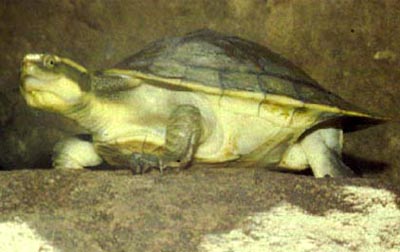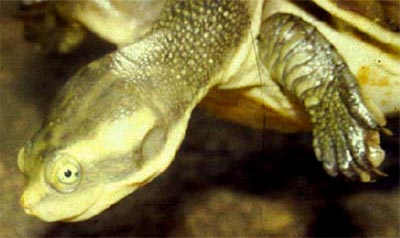Northern Yellow-faced Turtle -- Emydura tanybaraga
by Jan Matiaska
[1]

Introduction
Even though two Emydura tanybaraga specimens
were first collected by John Cann as early as in 1971, it took 26 years
before the species was properly described by John himself in 1997. The turtle
resembles other Northern Australian Emydura species E. victoriae,
E. australis, and mainly E. subglobosa worrelli. Despite the morphological resemblance, Georges and Adams (1992) proved this turtle to be a distinct species. There
are three different populations inhabiting three ecosystems: one in Western
Australia, one in the Northern Territory (where the holotype comes from)
and one in Queensland. The morphological variations among these three populations
suggest there are most likely two or more species or subspecies present
in what we currently recognize as the Emydura tanybaraga species.
Further research is required in order to understand the species' diet and
breeding ecology.
Right photo: Emydura tanybaraga; notice its "deep body appearance"
History and type data
The holotype A.M. R125498 was collected by Dr Arthur Georges on the 5th of November 1987. The holotype is an adult male with the carapace length and width 167.0 mm and 135.0 mm respectively and the plastron length and width 142.5 mm and 55.0 mm respectively and the head width 30.5 mm (Cann, 1998). The type locality is the Policeman Crossing [13°46'S x 130°43'E], The Daly River, Northern Territory. There is a number of paratypes, two of which were collected by John Cann in 1971 that are stored in the collection of the Australian Museum, Sydney. Paratypes: A.M. R31723-4, A.M. R128999 whole juveniles, A.M. R125499, A.M. R125492 and N.T.M. R20416 adult male. All the paratypes are from the same location as the holotype (Cann, 1998).
Etymology
Tanybaraga is the name given to the adult yellow-faced
turtle in the Daly River by the Ngangi Kurunggurr group at the Daly River.
The species name is to be used as a noun in apposition. This is pronounced
tanybar-arrga (Cann, 1998). Its grammatical gender is feminine. The common
name of the species is the Northern Yellow-faced Turtle.
Bottom photo: Emydura tanybaraga
 Morphology
Morphology
Emydura tanybaraga has a great morphological
variation between different areas (Cann, 1998) which may eventually lead
to splitting the species to more than one species or subspecies.
The carapace of juveniles is pear shaped and becomes oval in adults. The
posterior rim of the carapace is without serrations. The carapace can be
of light brown to dark brown colour with a yellow or white rim created by
outer edges of marginals having their ventral colour extending on the outer
edge dorsally. Some carapace flaring occurs from the sixth, seventh or eighth
(depending on age) marginal towards the rear of the carapace. The longest
carapace records include 285 mm [Finniss], 250 mm [McKinley], 210 mm [Daly]
(Cann, 1998).
The plastron is tapered towards the rear with lobes at both ends turned
up making the adult turtle look deeper. It is bone coloured and traces of
pink may occur occasionally.
Dorsal skin colour is steel grey while ventral soft parts are creamy white
or yellow in juveniles. The neck is covered with small smooth tubercles
(Cann, 1998) like in other Emydura spieces. Two barbells can be
present on the chin, but not always.
As for colouration, a light yellow band runs from the eye to just above
the tympanum. Another band extends from the angle of the mouth along the
neck. The eye has dark markings through the iris at the level of the pupil
(Cann, 1998). When younger, Emydura tanybaraga can be tell apart
from other northern Emydura species by different facial markings,
but it may be quite tricky to distinguish between E. tanybaraga
and E. subglobosa worrelli once they reach the adult stage (Cann,
1998). More information can be found in the article written by Scott Thomson
- Distinguishing
the Yellow-Faced Turtle and the Diamond Head Turtle.
